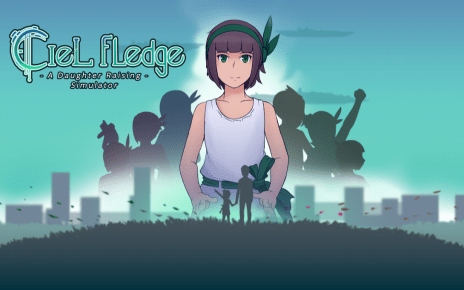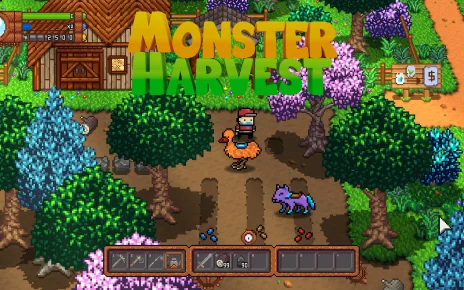Released on 11 August 2021 for PC and Nintendo Switch, Garden Story is an indie action role-playing game (ARPG) developed by Picogram and published by Rose City Games. Join Concord, the youngest grape of the Grove, as they work with the other inhabitants to help save and rebuild their home that has been invaded by the Rot.
For this review, the game (v1.0.6 to v1.0.7) was played on a PC using keyboard controls. While the estimated playtime is 15 to 20 hours, I took around 40 hours for a complete playthrough — but was the adventure with our grape protagonist sour or sweet?
From Gardener to Guardian
The main story of Garden Story is linear, short, and follows a typical plot where the protagonist rises up to the grand task of saving the day. Initially acting as a gardener taking care of the vine inside the Kindergarden, Concord is soon appointed as a Guardian to help with the increasingly dire situation happening around the Grove caused by the aggressive Rot. Their journey starts from Spring Hamlet and the main questline will bring them to three other towns in sequence according to the seasons: Summer Bar, Autumn Town, Winter Glade. But before they can move on to the next town, Concord has to first vanquish the boss enemy of the current town. Action, therefore, forms a significant component of this game. Although the main boss battles cannot be skipped and the difficulty level is fixed, Garden Story has a “perish prevention” mode where Concord’s health points (HP) will never drop below one.

Boss battles aside, regular enemies will be encountered in several areas of every town that has been touched by the Rot. It is possible to avoid fighting these enemies by running or rolling past them, though there are times when clearing them is necessary as they can interrupt Concord’s activity. For instance, if Concord was in the midst of pulling a resource from the water when a nearby enemy injures them, they will lose their grip on the line and have to recast it. So, even though there are several non-combat things to do in Garden Story, one should not expect the focus on combat to be minimal. With that in mind, let’s look at Concord’s adventure in greater detail.
Journey at Your Own Pace
A day in the Grove is split into five time frames, namely morning, day, evening, night, and after dark. Some locations and shops are open during specific periods of the day, and a few characters can only be found or interacted with at set times too. Enemies that roam around at night are also more aggressive than those seen during the day. Apart from these few time-dependent groups, there is little need to pay much attention to the time of the day as Concord can continue with their activities for as long as they wish into the after-dark hours. Unless Concord perishes in a fight, they will not pass out from exhaustion and be forced to rest till the next morning. Players can thus take their time to forage or explore the town until they are satisfied and ready to end the day by returning to Concord’s home to sleep. One disincentive, though, for Concord to stay up late into the night is the absence of background music to listen to; it feels chilly and desolate whenever Concord hops around the silent town at night.
Another intriguing aspect of the time system in Garden Story is how time flows constantly in the background but will not shift from, say, the end of the morning to the start of the evening until Concord transits from the current map area to a new area. At first, I could not quite get used to this design since it makes the flow of time feel intermittent. Once I see how it can be used to my advantage, though, I start to appreciate it. With this little time stopper in place, I can enter a town area in the late evening and not worry that the shops there are going to close for the night soon. Instead of rushing into the shops the first thing I get there, I can take my time to do some stuff around the same area before finally strolling into the shops.

With the main quests having no time limit as well, Garden Story provides players with much control over the pace they wish to play the game at. Furthermore, for players who want an even more laid-back experience, they can opt for a slower time flow under the gameplay settings. And for those who want to speed time up — especially when Concord has tasks that can only be attended to at night but has nothing else to do before then, or when Concord is done for the day but cannot sleep because it is not yet evening — there are benches in every town which Concord can sit on to pass the time quickly.
Always Something to Do Every Day
Concord’s day begins when they wake up from their Pillow Leaf, at which point the game will auto-save. Up to three random requests will be available for Concord to work on for the day, details of which can be checked by interacting with the request board outside of Concord’s home. These daily town requests fall into one of the three categories (Conflict, Maintenance, Forage) and tiers (one star to three stars). Conflict requests require Concord to fight some Rot enemies, Maintenance requests involves fixing broken stuff within the town using a specified material or tool, and Forage requests ask for a particular material to be gathered. Completing the daily requests will raise the town’s corresponding levels in its Conflict, Maintenance, and Forage stats. And the amount of stat raise is determined by the tier of the request, with three stars giving the highest raise. However, due to the randomness in the total number, category, and tier of requests assigned each day, it is possible for some stats to level up faster than the others. This evoked slight annoyance when I was aiming to raise all three stats to the max, but for a few consecutive in-game days the game just refused to throw me requests for the very stat the town was lagging far behind in.
Despite having tasks that are unique to each town, the daily requests generally have few variations and lose their freshness fairly quickly as a result. I remember in particular how Concord has to fix the same well in Spring Hamlet every other day to the point I wanted to tell Sili to stop damaging the poor well. Nevertheless, such a consistent theme of fighting, fixing, and foraging helps to lay a comfortable rhythm to Concord’s daily undertakings, which is great for players who enjoy the familiarity and assurance felt from a more or less repetitive routine.

On top of having more variations, another thing the daily requests can improve on is to make its task information easier to be processed at a glance. The requests are presented in the form of complete sentences detailing the task with both key information such as the location, and additional information like the requestor’s identity. They may be two to three sentences long but oftentimes, I find myself immediately forgetting what the important information is once I exit the request board screen. Since Garden Story neither records nor marks the daily requests on the map, I end up having to check the requests at the nearest request board multiple times. This happens most often when dealing with Conflict and Maintenance requests. For Forage requests, there is no need to double-check since approaching any forage box in town will immediately tell me which material and how much of it is needed.
A Bunch of Activities, Kind of
Besides town requests, there are other activities Concord can engage in. The catch, however, is that Concord has to progress the main storyline forward in order to obtain new tools that will allow Concord to partake in the full range of activities that the game has in store. Locking specific tools behind specific towns helps inject excitement and surprise into the game every time Concord reaches a new place and acts as an incentive for moving onwards to the next town, but it inevitably means some activities will be introduced much later. Fortunately, Garden Story allows players to continue playing past the end-game, so one can technically spend as much time as they want on an activity even if it has a late introduction point.
Nevertheless, of all the activities, I find myself spending the least time on gardening and building infrastructure. This is due to two reasons. First, these two activities are pretty much stand-alone and not strongly tied to the town system. There is basically little to no incentive to do them. I have only grown crops to buy upgrades, complete the Library’s catalogs, or as a cheap alternative to refill the Dew Jars, and mostly made repair boxes to open up new areas and storage boxes for my convenience. Other times, I ignore them altogether. Second, they can only be done at designated small places. Unlike games that give players a fairly huge land to freely place and move items around, Garden Story has a fixed structure to its towns. Any crop or new infrastructure has to be placed within the constraints of the given layouts, which I find is too limiting to make these activities enjoyable for me. As a crucial example, I can’t even decorate Concord’s home much! Not to mention, the terrible distribution of garden plots at two opposite ends of Summer Bar makes me dread growing crops there.

As for an activity that I spent a lot of time on but found little joy from, that will be gathering resources. Towards the end of my playthrough of Garden Story, I find myself only gathering resources as and when they are needed or when I have nothing better to do. The most tedious part in gathering resources, specifically for foraging on land, is how Concord has to manually pick up the resources themself. Players can do this by pressing the “Pickup” button once for each resource to be picked up, or hold onto it and wait for the nearby resources to be swept into Concord’s inventory. Of course, the second method is more welcome (imagine pressing the button ten times to pick up ten resources) but is still not as ideal with its noticeable pause before the resources are finally gathered. Then, there is also the part of Concord having to travel everywhere on their tiny feet. Fast travel points are introduced quite late in the game and even with them, there are many places that Concord can only walk or run to. What’s more, when Concord has yet to get any backpack stacking upgrade, they would likely be running back and forth between a foraging area and the storage box or a general trader in another area very frequently.
Dowsing, the other kind of resource gathering where Concord uses a Dowsing Rod to snag stuff from the waters, is slightly better. It may have a timed mini-game but as of v1.0.7, players can turn the timer off. There is also only one resource to get with each dowsing spot in the water. But the problem comes when Concord has to use the Dowsing Rod to grab a group of resources from places they cannot physically reach; the process is so tedious, I don’t even want those resources anymore. In one of the towns, there is an offshore sandstone that can only be reached with the Dowsing Rod. Breaking the sandstone usually gives more than one resource, so it means having to cast the line out multiple times to get them all as the Dowsing Rod catches only one item at a time. Additionally, casting the Dowsing Rod’s line uses stamina, hence if Concord does not have much stamina, they are going to have to wait a bit before they can cast the line again. Funnily enough, there is a jar in the same town which when broken, all pieces will magically slide across the uncrossable gap towards Concord. If only all resources behave in the same way…
Beat the Rot to a Pulp!
In Spring Hamlet, Concord will be introduced to all the basic things needed for combat: a weapon for attacking, a shield for blocking, and a Dew Jar for storing dew that restores HP upon consumption. Controls are pretty standard and key bindings can be remapped for those who are playing using a keyboard (there are no mouse controls). Garden Story has a generally informative Tutorial, though most of the learning occurs through trying things out. If there is anything I was confused about with regards to combat controls at the beginning, it would be how the charged attack works. It took me a while to get a hang of unleashing the charged attack in the direction I want because its actual behavior is different from what I expected. I have thought the charged attack would unleash in whichever direction Concord was heading to at the moment when I release the “Main Tool” button, but it is actually not so intuitive.

I also had a small confusion about whether a tool was already equipped, mainly because I misunderstood the meaning of the backpack image at the bottom left corner of the screen. When a weapon is equipped, it shows up on the left side of the backpack, which I initially thought depicted that I had stashed the weapon away. Going to the Inventory screen for primary and secondary tools did not help clarify things either as no matter if the cell for the weapon was highlighted or not, the prompt was always “Equip Tool” and noted nothing about unequipping.
Something else that is unclear is how one can assign tools and Dew Jars to the four hotkey slots. The process turns out to be very simple, just a matter of pressing the corresponding hotkey button while the item in the inventory is highlighted, but nothing in the game mentioned anything about this handy feature.
Past those minor confusions, the combat in Garden Story works similarly to other real-time fighting games. There are Concord’s HP and stamina to look out for, though the current warning cues for low health and stamina are not attention-grabbing enough and I would often not notice Concord was low on health or stamina in the middle of a busy fight. For this 2D ARPG, Concord can also move diagonally but almost all weapons only attack in the four cardinal directions. In terms of response time, everything works reasonably fine except a few times when the Parasol’s quick attacks refuse to keep up with my input speed, causing me to break its triple combo. In addition, there is a wait time before an attack can be switched to anything else as the game would not register the new command unless the current attack animation has finished.

To gain more HP and stamina, instead of accumulating experience points and leveling up, Concord will be breaking special orbs that are scattered around the Grove. Several orbs require a specific weapon to break open while a few just need an upgraded weapon that can deal strong enough attacks. For the latter type, a standard prompt of Concord needing a stronger weapon will be shown if the attack they dealt cannot surpass the orb’s defense value. Such a prompt can be misleading as it is possible that the player is already using a sufficiently upgraded weapon that can break the orb, but they simply have to make a charged attack instead of a regular attack. Yet this distinction between a stronger weapon and a stronger attack is not conveyed through the given prompt.
Concord can gain several perks to their character stats and skills through the Memories system, which can be accessed at the Pillow Leaf. Each memory has its unique requirement to unlock and details of these criteria are given under the Memories screen. Most memories can be unlocked without much conscious effort by playing the game normally. At most, some require the player to deliberately explore various aspects of Garden Story. Still, none is as exhausting as the memory that needs Concord to run around in a stated location for ten minutes.
In comparison, weapon and Dew Jar upgrades are more straightforward; Concord merely has to buy them from the shops around the Grove. Upgraded items paired with memories that boost their functions help Concord heal or deal damage more effectively and efficiently.

My favorite weapons are the Pick for its sweep range and the Parasol for its swift attacks. For most others, I use them only in situations that specifically require them, and (no offense, Plum) I find the Spade to be the worst main tool to use, even for gardening. If I have not equipped the Seed Pouch that gives me additional guiding visual cues, I will quite certainly stand too close and hit off-target whenever I try to dig holes in the garden plots with the Spade alone.
Dungeons and Puzzles
Rot enemies in Garden Story have distinct movement and attack patterns, which make them memorable despite the bulk of them having similar base designs for their appearances. Rather than pure rushing in and whacking at the enemies, players would probably find the fights easier to handle if they take a few seconds to study the enemy first. After all, there are enemies that have to be hit by a certain damage type before they become vulnerable to all damage types. Among the regular Rot enemies, I find the Acorns to be the most challenging to fight due to their agility in chasing Concord and spewing a barrage of projectiles immediately once they are close. Glomps deal quite heavy damage when they ram into Concord, but if they are encountered in places with plenty of space, it would be easy to run away from their limited movement paths.
Every town has a dungeon where a boss enemy resides. The deepest a dungeon goes is ten floors, and players can leave from any floor (except, sadly, for Winter Glade’s dungeon) though they will always begin from the first floor when they re-enter the dungeon. The inability to directly skip to a particular floor can be frustrating especially since every dungeon in Garden Story has a few floors that are puzzle-based. Moreover, there is no option to skip or auto-complete these puzzles even after they have been solved once. This means one has to redo the exact same puzzles all over again each time they descend into the dungeons, be it to retry the boss battle or for fulfilling a town request. Autumn Town’s dungeon is the worst offender with puzzles that require the most time to complete, and I imagine those who struggle with rhythm-based puzzles are going to find Summer Bar’s dungeon bothersome to go through.

The only boss enemy I find difficult is Spring Hamlet’s, primarily because at the point when Concord has to fight it, they only have a tiny amount of HP and stamina and carry just one Dew Jar. My patience ran thinner each time Concord could not defeat the boss and I eventually made use of the “perish prevention” mode to get the fight over and done with. Though, note that I fought this boss enemy before it was subsequently nerfed in the v1.0.7 update. Compared to Spring Hamlet’s boss, the other bosses are easier to defeat. Concord can emerge from Summer Bar’s boss battle victorious without getting hit even once, and they can conduct a jolly choir in the midst of Autumn Town’s boss battle — the best highlight for me.
Strut in Style
Whilst entirely optional, cosmetic items form one of my favorite aspects of Garden Story. An assortment of hats and backpacks can be bought from shops, and I find it entertaining to dress Concord up every now and then. I mean, somehow, the sight of a grape wearing a snorkel had me laughing my socks off. And with the v1.0.7 update where the backpack image now shows the backpack Concord has equipped, there is even more reason to try carrying different backpacks. Last but not least, players can freely mix and match Concord’s hats and backpacks to create a certain look, such as donning the Summer Rain Cap with the Ocean Courier Bag to give a “Tourist in Summer Bar” look, or the Sparkle Cone with the Book Bag to create a Magician look.
Cozy Towns and Jovial Folks
All four towns in the Grove are brought to life via the art, layout design, and music. Color palettes reminiscent of the seasons are used along with layouts that are unique and relevant to the individual town’s lore. The weather changes every day and snow can be seen in Winter Glade. However, what drew me in the most is the music. The moment I got to Autumn Town, I instantly fell in love with its theme and wanted to stay there forever, listening to its calming tune as I lay down next to the wheat field and doze off under the sunset. Indeed, I find Garden Story’s entire soundtrack relaxing to listen to.

Like the towns they live in, the inhabitants have marked personalities. Several characters are quite memorable, including those who do not have a big role in the main storyline. Sili, for example, will forever be remembered by me as the well destroyer. Sometimes, I would also wonder about Ama and if they have finally posted something on the request board. On the other hand, I tend to overlook those with a favor to ask, like Maraschino even when they practically stand outside Concord’s home every night. These characters having few dialogue variations did not help matters either.
Verdict
With elements and features that allow players to truly take their time playing, Garden Story is an excellent choice for those looking for an easygoing game. Although some core activities can get tedious due to the system design, and gardening and building could have been more fun or at least more purposeful, it has been a wonderfully pleasant journey on the whole. From the melodious music to the pleasing pixel art and cute characters, there is plenty to savor in this game.
GARDEN STORY IS RECOMMENDED

If you enjoy RPG games, perhaps you’d like to take a look at Xuan Yuan Sword 7?
Many thanks goes to Rose City Games for a PC review code for this title.

A person with many hobbies (and even more WIPs), KuroKairin plays, playtests, and reviews PC games. She loves games with good stories that bring her on an emotional and thought-provoking journey. Her favourite genres include otome visual novel, point and click, puzzle, and RPG. Follow her @KuroKairin.




